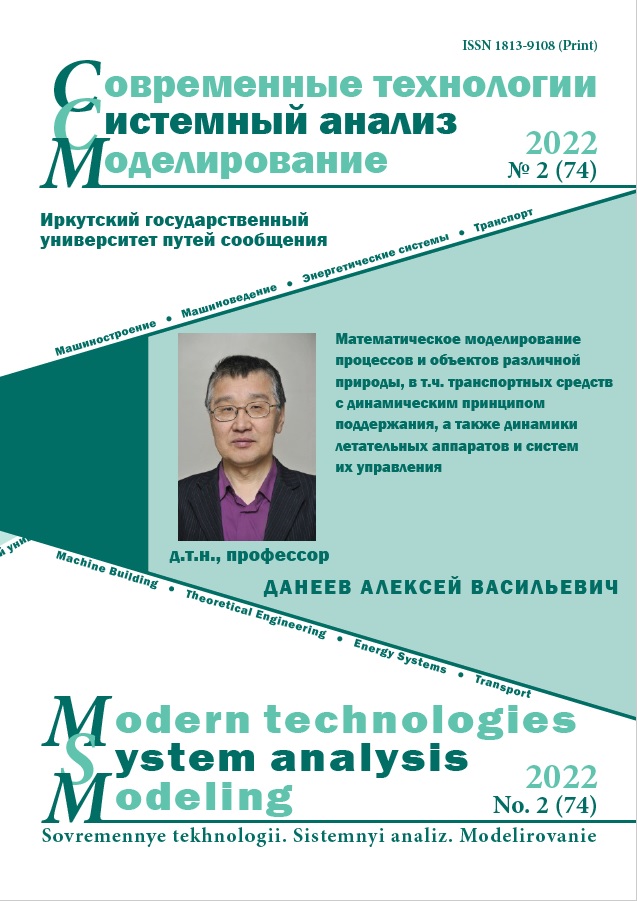The bar dynamic behavior simulation by repeatable loading at the laboratory conditions
Keywords:
damping, dynamics, bending, vibrations, finite element method, resistance of materials, resonance, strain gauging, frequency response, electronicsAbstract
The article deals with revision of the stand for modelling at the laboratory conditions of repeatable loads dynamic loading simulation with various frequencies. Load frequency can be regulated, which allow to simulate of bar bend dynamic behavior at the subcritical, critical and supercritical modes. To take into account the influence of the distributed mass of the beam on the vibration eigenfrequency and the forced vibrations amplitude, the installation behavior was simulated by the finite element method; the beam mass coefficients of reduction to the oscillator installation point were calculated. Construction of stand allows calibrating it at the static load mode before experience that exclude influence uncontrollable parameters. Stand oscillates by rotor of the step motor that provides high accuracy of excitation frequency measurement and maintain it constant. The system behavior at static and dynamic loading is monitored by measuring the deformations at the control section using strain gauges and an oscilloscope that records the signal level from the resistive-strain sensors over time. The article deals with principal schemes of oscillator driver and resistive-strain sensor signal amplifier. The oscillator driver principal scheme has module of motor rotation frequency measurement. The installation is equipped with a damping element that limits the oscillations amplitude at modes close to resonance; the damping coefficient is determined during preliminary calibration using the oscillogram of natural damped vibrations. To select an eccentric that provides the required value of imbalance, a numerical calculation was made using the finite element method, revealing the permissible range of imbalances in terms of the strength and rigidity of the installation.
References
Александров А.В., Потапов В.Д., Державин Б.П. Сопротивление материалов. М. : Высшая школа, 2000. 560 с.
Сопротивление материалов / Г.С. Писаренко, В.А. Агарев, А.Л. Квитка [и др.]. Киев : Вища шк, 1986. 775 с.
Бабаков И.М. Теория колебаний. М. : Дрофа, 2004. 591 с.
Тимошенко С.П., Янг Д.Х., Уивер У. Колебания в инженерном деле. М. : Машиностроение, 1985. 472 с.
Александров А.В., Потапов В.Д. Основы теории упругости и пластичности. М. : Высш. шк., 1990. 400 с.
Тимошенко С.П., Гудьер Дж.Н. Теория упругости. М. : Наука, 1975. 576 с.
Феодосьев В.И. Сопротивление материалов. М.: МГТУ им. Н. Э. Баумана, 1999. 592 с.
Писаренко Г.С., Яковлев А.П., Матвеев В.В. Справочник по сопротивлению материалов. Киев: Наукова думка, 1988. 736 с.
Зенкевич О. Метод конечных элементов в технике. М. : Мир, 1975. 542 с.
Chen Z. Finite Element Methods and Their Applications. Berlin: Springer, 2005. 411 p.
Дудаев М.А. Матрица жесткости балки Тимошенко в конечноэлементном анализе динамического поведения роторных турбомашин // Вестник ИрГТУ. 2014. № 6. С. 59–65.
Иванов-Смоленский А.В. Электрические машины учеб. для вузов по напр. подготовки диплом. спец. «Электротехника, электромеханика и электротехнологии» : в 2-х т. Т. 2. 2-е изд., перераб. и доп. М. : МЭИ, 2004. 532 с.
Опадчий Ю.Ф., Глудкин О.П., Гуров А.И. Аналоговая и цифровая электроника. Полный курс. М. : Горячая линия-Телеком, 2000. 768 с.
Bathe K.J. Finite Element Procedures. Upper Saddle River, New Jersey: Prentice hall, 1996. 1037 p.
Лойцянский Л.Г., Лурье А.И. Курс теоретической механики : в 2-х т. 6-е изд., перераб. и доп. М. : Наука, 1983. Т. 2. Динамика. 640 с.
Электрические измерения / Л.И. Байда, Н.С. Добротворский, Е.М. Душин [и др.]. Л. : Энергия. Ленингр. отд. 1980. 392 c.
Рудаков К.Н. FEMAP 10.2.0. Геометрическое и конечноэлементное моделирование конструкций. Киев: Киевский по-литехнический институт, 2011. 317 с.
Шумейко И.А., Зайченко Н.О. Анализ пластмасс при их выборе для 3d печати модели ветроэнергетической установки // Universum: технические науки. 2021. №3-1 (84). С. 74 – 77.


